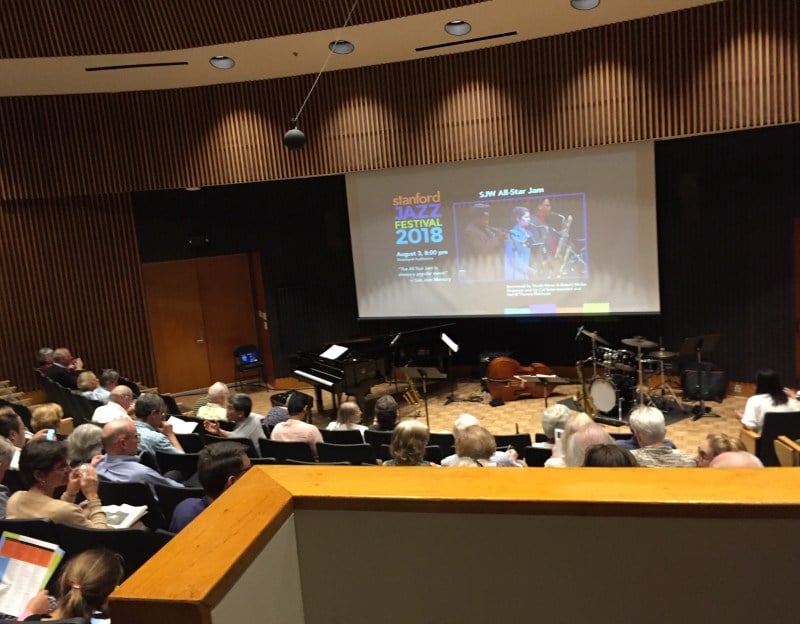“You don’t have to have a lot of knowledge to appreciate jazz – you just have to open your ears,” said Jim Nadel, jazz saxophone player and Stanford jazz lecturer, who dedicated himself to educating jazz students from around the world for over 30 years.
This summer, his Stanford Jazz Workshop attracted over 700 students from all around the world, a dramatic increase in attendance compared to the 20 students who participated when the workshop first began 47 years ago.
In 1972, Nadel founded the nonprofit Stanford Jazz Workshop to educate aspiring jazz students. The program started out as a small workshop during the summer in which students would perform at CoHo on Monday nights. The following Tuesday night, they would reconvene to discuss the music.
“So that turned out to resonate with musicians. They liked it, and I liked it, so we did it again,” said Nadel.
In 1982, Nadel invited Stan Getz, a famous jazz saxophone player who had spent 40 years touring the world, to be a guest lecturer during the summer. According to Nadel, this was big news in the jazz world, and that summer, the Stanford Jazz Workshop saw an international presence for the first time, with European students attending the program. Each year in the 1980s, the workshop doubled in size as it acquired new groups of students from all around the world, according to Nadel
Each year, the Stanford Jazz Workshop invites the best jazz performers and lecturers to Stanford so they can share their diverse experiences and techniques with students. With four separate summer workshops, designed to accommodate a variety of age groups and genres, the workshop has established an inclusive community that welcomes all jazz enthusiasts.
“My idea, which is at the base of all the educational programs we do, is [to] set up a community of musicians where many different point of views are represented,” Nadel said. “You have some Latin jazz players… some traditional New Orleans jazz players and… some contemporary New York jazz players, and you have people from all different ages and different styles and different backgrounds.”
Nadel said, “They come together to teach, and the students can wander through this community of different points of view and see what resonates with them.”
Christina Galisatus, a three-year participant of and three-year counselor for the Stanford Jazz Workshop, said that “it truly changed… [her] path as a musician and also introduced [her] to some… people who have really impacted [her] life.” From talking to other people who have experienced or have worked at the Stanford Jazz Workshop, Galistatus said she knows that many others feel the same way.
Mackenzie Karbon, another alumna from the Stanford Jazz Workshop, said that the workshop “let [her] understand why it is [she] even play[s] music.”
“It just was… a thrilling environment to be in,” Karbon said.
From late June to early August, the workshop features its summer jazz groups and professional jazz performers in the Stanford Jazz Festival. In total, there will be 28 concerts at the Stanford Jazz Festival.
Jim Nadel & Friends, a new group Nadel assembled for a performance on June 22, kicked off the Stanford Jazz Festival at the Campbell Recital Hall with “Big Bertha,” a 1964 jazz tune that Nadel played to introduce his audience to blues and swing rhythms. In addition to playing a variety of jazz tunes, Nadel, pianist Fred Harris, drummer Lorca Hart, bass player Kanoa Mendenhall, tenor saxophonist and flutist Eli Maliwan, and trumpeter Ian Carey discussed the history and musical components of jazz, establishing an interactive session in which the audience had an opportunity to pose their own questions.
Nadel said that his goal for Friday’s interactive performance was to immerse the audience in the rich language of jazz and to provide them with a newfound appreciation for and knowledge of the jazz world. Elementary school children and seniors alike posed questions throughout the session, as diverse as why saxophones need reeds and how certain improvisation come to life. When questions arose about the preparation and interpretation of music for Friday’s jazz performance, Nadel shared — to the audience’s audible surprise — that Friday night was the first time that he and his performers had ever played a jazz tune together. Nadel also revealed that he did not have any sheet music on-stage, as he played jazz by ear and had confidence in his fellow performers’ abilities. The group closed Friday night’s performance with the jazz tune, “Have You Met Miss Jones.”
Nadel’s performances throughout the years have encouraged many jazz enthusiasts to return to learn more about the diversity of the jazz world.
As one audience member said, “The little that I learned showed me how much I didn’t know.”
Others have been coming to Nadel’s performances for years not only to learn about jazz, but also to experience the complex richness in the music itself.
As for the future of the Stanford Jazz programs, Nadel plans to continue introducing new artists and voices to maintain the diversity of the community. From Afro-Cuban jazz to Indian jazz, Nadel is setting the Stanford Jazz Workshop in a promising path, and he believes that as the world gets smaller, the umbrella of jazz will get bigger, bringing more kinds of jazz for people to experience and to enjoy for years to come.
Contact Jonathan Liu at liujonathan41741 ‘at’ gmail.com.
